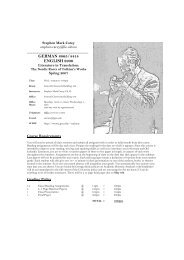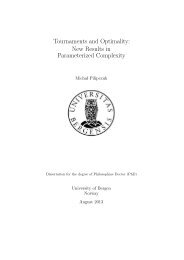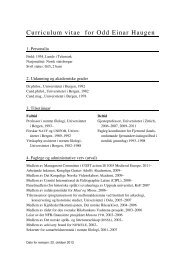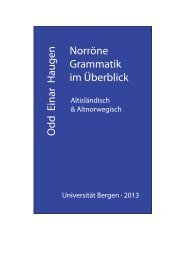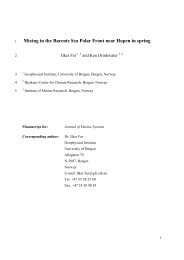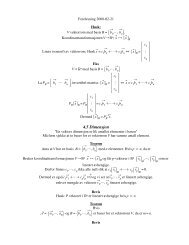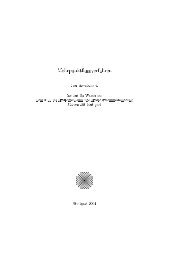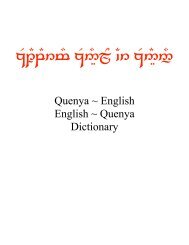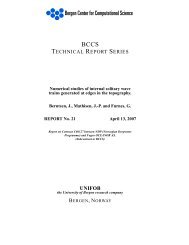a commentary on jrr tolkien's tengwar transcription of
a commentary on jrr tolkien's tengwar transcription of
a commentary on jrr tolkien's tengwar transcription of
Create successful ePaper yourself
Turn your PDF publications into a flip-book with our unique Google optimized e-Paper software.
Third, in the case <strong>of</strong> dissyllabic vocalic clusters as in -ie the first ómatehta is written<br />
above the preceding tengwa, and then the next vowel sign is written above a single<br />
short carrier.<br />
Altariello: Because this word begins with a vowel, the Tengwar script versi<strong>on</strong> begins<br />
with the vowel diacritic for a written above a short carrier. Note that in the original<br />
versi<strong>on</strong> the a-diacritic is simplified to look like a circumflex.<br />
The obvious reas<strong>on</strong> for this is that writing three dots with a nib pen would be difficult<br />
if <strong>on</strong>e is writing small letters and even smaller diacritics; but Tolkien also<br />
wrote that this practice was comm<strong>on</strong> am<strong>on</strong>g scribes because the a-sound occurs so<br />
frequently that writing the simplified form is much more c<strong>on</strong>venient, especially if<br />
<strong>on</strong>e is in a hurry — or if no c<strong>on</strong>fusi<strong>on</strong> would occur, eliminated altogether. Tolkien<br />
gives the word calma “lamp” as an example: <strong>on</strong>e can actually dispense with writing<br />
the a-diacritic altogether (ajt), because the word calama does not exist.<br />
It is also in this word that we first encounter the use <strong>of</strong> the under-stroke under a<br />
tengwa to indicate that the c<strong>on</strong>s<strong>on</strong>ant is doubled: j° = ll. 5<br />
nainië: This word illustrates that diphth<strong>on</strong>gs — in this case ai — are written by<br />
writing the preceding vowel sign over the following semi-vowel tengwa, in this case<br />
the tengwa yanta. Such is also the case with the interjecti<strong>on</strong> ai! But not always so;<br />
see the ommentary under caita. See also laurië.<br />
laurië: As in the entry nainië above, the diphth<strong>on</strong>g au is written with thevowel sign<br />
for a above the semi-vowel tengwa úre.<br />
lantar: This is the first time that <strong>on</strong>e encounters the tengwa óre representing r,<br />
whereas r in the words Namárië, Lóriendesse and laurie above is represented by<br />
rómen. The latter letter is a modificati<strong>on</strong> <strong>of</strong> óre, used originally to represent a trilled<br />
r, while óre was used to represent a weak (untrilled) r, originally occurring in Quenya.<br />
However, as Tolkien noted, this distincti<strong>on</strong> was later lost, and the r-sound is<br />
trilled in all positi<strong>on</strong>s and not lost pre-c<strong>on</strong>s<strong>on</strong>antally. In theory, therefore, <strong>on</strong>e can<br />
use either óre or rómen to represent r in any positi<strong>on</strong>, but in practice am<strong>on</strong>g scribes<br />
to use óre to represent pre-c<strong>on</strong>s<strong>on</strong>antal and final r, while rómen is used to represent<br />
intervocalic r. 6<br />
lassi: Note here that Tolkien used the usual ómatehta for e to represent i in this<br />
case. Although this is allowed, the use <strong>of</strong> <strong>on</strong>e or the other should be c<strong>on</strong>sistent<br />
throughout.<br />
súrinen: I have written before that the s in súrinen should have been rendered with<br />
the tengwa súle (older thúle), not silme. I had made this assumpti<strong>on</strong> because <strong>of</strong> the<br />
existence <strong>of</strong> the root THŪ “blow”. 7 However, it turns out that there exists a variant<br />
stem SŪ “wind”, 8 therefore the use <strong>of</strong> silme is indeed correct.<br />
Yéni: This is the first time <strong>on</strong>e encounters the tengwa anna with y-diacritic written<br />
below the letter to represent c<strong>on</strong>s<strong>on</strong>antal y. The tengwa anna does have any value in<br />
Quenya though in early Quenya it had the value <strong>of</strong> the back spirant ʒ, which later<br />
became lost. 9 But by the Third Age this had the value <strong>of</strong> c<strong>on</strong>s<strong>on</strong>antal y when combined<br />
with the y-diacritic: hÎ.



